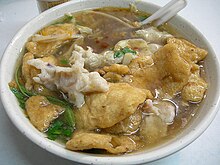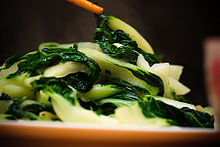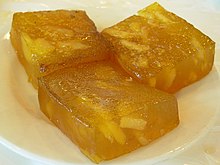Chinese cuisine
This article needs attention from an expert in Food and drink. Please add a reason or a talk parameter to this template to explain the issue with the article. (June 2011) |
| Part of a series on |
| Chinese cuisine |
|---|
 |

Chinese cuisine is any of several styles originating from regions of China, some of which have become increasingly popular in other parts of the world – from Asia to the Americas, Australia, Western Europe and Southern Africa. The history of Chinese cuisine stretches back for many centuries and produced both change from period to period and variety in what could be called traditional Chinese food, leading Chinese to pride themselves on eating a wide range of foods. Major traditions include Anhui, Cantonese, Fujian, Hunan, Jiangsu, Shandong, Szechuan, and Zhejiang cuisines.[1]
Eight Culinary Traditions of China
Chinese dishes may be categorized as one of the Eight Culinary Traditions of China, also called the "Eight Regional Cuisines" and the "Eight Cuisines of China". They are as follows:
- Hui: Anhui
- Yue (Cantonese): Guangdong
- Min: Fujian
- Xiang: Hunan (Can include Xiangjiang Region, Dongting Lake and Xiangxi styles)
- Su (aka Huaiyang Cuisine): Jiangsu
- Lu: Shandong (Include Jinan, Jiaodong styles, etc.)
- Chuan: Sichuan
- Zhe: Zhejiang (Can include Hangzhou, Ningbo, and Shaoxing styles)
Regional cuisines
This section needs expansion. You can help by adding to it. (April 2011) |

A number of different styles contribute to Chinese cuisine, but perhaps the best known and most influential are Guangdong (Cantonese) cuisine, Shandong cuisine, Jiangsu cuisine and Sichuan cuisine.[2][3][4] These styles are distinctive from one another due to factors such as available resources, climate, geography, history, cooking techniques and lifestyle. One style may favour the use of lots of garlic and shallots over lots of chilli and spices, while another may favour preparing seafood over other meats and fowl. Jiangsu cuisine favours cooking techniques such as braising and stewing, while Sichuan cuisine employs baking, just to name a few.[2] Hairy crab is a highly sought after local delicacy in Shanghai, as it can be found in lakes within the region. Beijing Roast Duck (otherwise known as 'Peking Duck') is another popular dish well known outside of China.[2] Based on the raw materials and ingredients used, the method of preparation and cultural differences, a variety of foods with different flavours and textures are prepared in different regions of the country. Many traditional regional cuisines rely on basic methods of preservation such as drying, salting, pickling and fermentation.[5]
Chuan (Sichuan)
Szechuan cuisine, also called Sichuan cuisine, is a style of Chinese cuisine originating in the Sichuan Province of southwestern China famed for bold flavors, particularly the pungency and spiciness resulting from liberal use of garlic and chili peppers, as well as the unique flavour of the Sichuan peppercorn (花椒, huājiāo) and zhitianjiao(指天椒, zhǐtiānjiāo). Peanuts, sesame paste and ginger are also prominent ingredients in Szechuan cooking.
Hui (Anhui)
Anhui cuisine (Chinese: 徽菜 or 安徽菜, Ānhuīcài) is one of the Eight Culinary Traditions of China. It is derived from the native cooking styles of the Huangshan Mountains region in China and is similar to Jiangsu cuisine. But it emphasizes less on seafood and more on a wide variety of local herbs and vegetables. Anhui province is particularly endowed with fresh bamboo and mushroom crops.
Lu (Shandong)
Shandong Cuisine is commonly and simply known as Lu cuisine. With a long history, Shandong Cuisine once formed an important part of the imperial cuisine and was widely promoted in North China. However, it isn't so popular in South China (including the more embracing Shanghai).
Shandong Cuisine is featured by a variety of cooking techniques and seafood. The typical dishes on local menu are braised abalone, braised trepang, sweet and sour carp, Jiuzhuan Dachang and Dezhou Chicken. Various Shandong snacks are also worth trying.
Min (Fujian)

Fujian cuisine is a Fujian coastal region.[1] Woodland delicacies such as edible mushrooms and bamboo shoots are also utilized.[1] Slicing techniques are valued in the cuisine and utilized to enhance the flavor, aroma and texture of seafood and other foods.[1] Fujian cuisine is often served in a broth or soup, with cooking techniques including braising, stewing, steaming and boiling.[1]
Su (Jiangsu, Huaiyang cuisine)
Jiangsu cuisine, also known as Su (Cai) Cuisine for short, is one of the major components of Chinese cuisine, which consists of the styles of Yangzhou, Nanjing, Suzhou and Zhenjiang dishes. It is very famous all over the world for its distinctive style and taste. It is especially popular in the lower reach of the Yangtze River.
Typical courses of Jiangsu cuisine are Jinling salted dried duck (Nanjing's most famous dish), crystal meat (pork heels in a bright, brown sauce), clear crab shell meatballs (pork meatballs in crab shell powder, fatty, yet fresh), Yangzhou steamed Jerky strips (dried tofu, chicken, ham and pea leaves), triple combo duck, dried duck, and Farewell My Concubine (soft-shelled turtle stewed with many other ingredients such as chicken, mushrooms and wine).
Yue (Hong Kong and Guangdong)
Dim sum, literally "touch your heart", is a Cantonese term for small hearty dishes.[2] These bite-sized portions are prepared using traditional cooking methods such as frying, steaming, stewing and baking. It is designed so that one person may taste a variety of different dishes. Some of these may include rice rolls, lotus leaf rice, turnip cakes, buns, shui jiao-style dumplings, stir-fried green vegetables, congee porridge, soups, etc. The Cantonese style of dining, yum cha, combines the variety of dim sum dishes with the drinking of tea. Yum cha literally means 'drink tea'.[2] Cantonese style is the unique and charm dishes, which enjoy a long history and a good reputation both at home and abroad. It is common with other parts of the diet and cuisine in Chinese food culture. Back in ancient times, and the Central Plains on Lingnan Yue Chu family has close contacts. With the changes of dynasty historically, many people escaped the war and crossed the Central Plains, the increasing integration of the two communities. Central Plains culture gradually moved to the south. As a result, their food production techniques, cookware, utensils and property turned into a rich combination of Agriculture, which is the origin of Cantonese food. Cantonese cuisine originated in the Han.
Xiang (Hunan)
Hunan cuisine is well known for its hot spicy flavor,[6] fresh aroma and deep color. Common cooking techniques include stewing, frying, pot-roasting, braising, and smoking. Due to the high agricultural output of the region, there are varied ingredients for Hunan dishes.
Xinjiang
The cuisine of Xinjiang reflects the region's many ethnic groups and refers particularly to Uyghur cuisine. Signature ingredients include roasted mutton, kebabs, roasted fish and rice. Because of the Islamic population, the food is predominantly halal.
Zhe (Zhejiang)
Zhejiang cuisine (Chinese: 浙菜 or 浙江菜, Zhèjiāngcài), one of the Eight Culinary Traditions of China, derives from the native cooking styles of the Zhejiang region. The dishes are not greasy, having but instead a fresh, soft flavor with a mellow fragrance.
The cuisine consists of at least four styles, each of which originates from different cities in the province:
- Hangzhou style, characterized by rich variations and the use of bamboo shoots
- Shaoxing style, specializing in poultry and freshwater fish
- Ningbo style, specializing in seafood
- Shanghai style, a combination of different Zhe styles, very famous for its dimsum
Other
Many other regions with unique dishes and styles are represented in China, including Hakka, Macau, Hainan, Taiwan, and Northeast cuisines.
Staple foods
Rice
Rice is a major staple food for people from rice farming areas in southern China.[citation needed] It is most commonly eaten in the form of steamed rice. Rice is also used to produce beers, wines and vinegars. Rice is one of the most popular foods in China and is used in many many dishes.
Noodles

Chinese noodles come dry or fresh in a variety of sizes, shapes and textures and are often served in soups or fried as toppings. Some varieties, such as Shou Mian (寿面, literally noodles of longevity), are symbolic of long life and good health according to Chinese tradition.[2]
Soybeans
Tofu is made of soybeans and is another popular product that supplies protein.[5]
Wheat
In wheat farming areas in Northern China, people largely rely on flour-based food, such as noodles, breads, dumplings and steamed buns.[2]
Vegetables

Some common vegetables used in Chinese cuisine include bok choy (Chinese cabbage), Chinese Spinach (dao-mieu), On Choy, Yu Choy, and gailan (guy-lahn).
Herbs
Herbs were important to the Chinese people, especially during the Han Dynasty.[citation needed]
Seasonings
When it comes to sauces, China is home to soy sauce, which is made from fermented soya beans and wheat. Oyster sauce, transparent rice vinegar, Chinkiang black rice vinegar, fish sauce and fermented tofu (furu) are also widely used. A number of sauces are based on fermented soybeans, including Hoisin sauce, ground bean sauce and yellow bean sauce. Spices and seasonings such as fresh root ginger, garlic, scallion, white pepper, and sesame oil are widely used in many regional cuisines. Sichuan peppercorns, star anise, cinnamon, fennel, and cloves are also used.[7] To provide extra flavors to dishes, many Chinese cuisines also contain dried Chinese mushrooms, dried baby shrimps, dried tangerine peel,[8] and dried Sichuan chillies as well.
Desserts


Chinese desserts are sweet foods and dishes that are served with tea, along with meals[9] or at the end of meals in Chinese cuisine.[citation needed] Bings are baked wheat flour based confections, and include moon cake Red bean paste pancake and sun cakes. Chinese candies and sweets, called táng[9] are usually made with cane sugar, malt sugar, honey, nuts and fruit. Gao or Guo are rice based snacks that are typically steamed[9] and may be made from glutinous or normal rice. Ice cream is commonly available throughout China.[9] Another cold dessert is called baobing, which is shaved ice with sweet syrup.[9] Chinese jellies are known collectively in the language as ices. Many jelly desserts are traditionally set with agar and are flavored with fruits, though gelatin based jellies are also common in contemporary desserts. Chinese dessert soups typically consist of sweet and usually hot soups[9] and custards.
Drinks
Tea

As well as with dim sum, many Chinese drink their tea with snacks such as nuts, plums, dried fruit (in particular jujube), small sweets, melon seeds, and waxberry.[2] China was the earliest country to cultivate and drink tea which is enjoyed by people from all social classes.[10] Tea processing began after the Qin and Han Dynasties.[10] Chinese tea is often classified into several different categories according to the species of plant from which it is sourced, the region in which it is grown, and the method of production used. Some of these are green tea, oolong tea, black tea, scented tea, white tea, and compressed tea. There are four major tea plantation regions in China. They are Jiangbei, Jiangnan, Huanan and the southwestern region.[10] Well known types of green tea include Longjing, Huangshan, Mao Feng, Bilochun, Putuofeng Cha, and Liu'an Guapian.[11] China is the world’s largest exporter of green tea.[11] One of the most ubiquitous accessories in modern China, after a wallet or purse and an umbrella, is a double-walled insulated glass thermos with tea leaves in the top behind a strainer.
Liquor
Yellow wine has a long history in China, where the unique beverage is produced from rice and ranges between 10–15% alcohol content.[2] The most popular brands include Shaoxing Lao Jiu, Shaoxing Hua Diao and Te Jia Fan.[2] Wheat, corn and rice are used to produce Chinese liquor which is clear and aromatic, containing approximately 60% alcohol. This also has a long history in China, with production believed to date back to the Song Dynasty.[2] Some popular brands of liquor include Er guo tou, Du Kang, Mao Tai, Lu Zhou Te Qu and Wu Liang Ye.[2]
Herbal drinks
Chinese herb tea, also known as medicinal herbal tea, is a kind of tea-soup made from purely Chinese medicinal herbs.[citation needed]
Milk
Chinese in earlier dynasties evidently drank milk and ate dairy products, although not necessarily from cows, but perhaps koumiss (fermented mare's milk). After the Tang dynasty there emerged a line dividing Asia into two groups, those who depend on milk products (India, Tibet, Central Asians) and those who reject those foods. Chinese depend on soy, as more efficient way of supporting density, and to differentiate themselves from border nomads. Most Chinese until recently have avoided milk, partly because pasturage for milk producers in a monsoon rice ecology is not economic, partly because milk products became negatively associated with horse riding, milk drinking nomadic tribes. There may even be a biological bias. A certain number of people in any ethnic group are lactose intolerant. In addition, human beings, like other mammals, after they are weaned, stop producing lactase enzymes (needed to digest milk) unless they drink milk. Lactose intolerance is then partly cultural, partly biological.[12]
But this non-dairy tradition has undergone some change as a result of the Occidentalization of China. For example, it has been suggested that, in the early 20th century Shanghai, “Western food, and in particular identifiably nourishing items like milk, became a symbol of a neo-traditional Chinese notion of family.” [13]
Styles
In most dishes in Chinese cuisine, food is prepared in bite-sized pieces, ready for direct picking up and eating. In traditional Chinese cultures, chopsticks are used at the table. Traditional Chinese cuisine is also based on opposites, whereby hot balances cold, pickled balances fresh and spicy balances mild.[citation needed]
Recent trends
According to the United Nations Food and Agriculture Organization, the number of undernourished people in the country has fallen from 386.6 million in 1969–1971 to 150.0 million in 2001–2003.[14][verification needed] Prior to the increased industrialization and modernization following the establishment of the People's Republic of China in 1949 (and the late 1950s famine), a typical Chinese peasant would have eaten meat or animal products (including fish and eggs) and most meals would have consisted of rice accompanied with green vegetables, with protein often coming from foods like peanuts and soy products.[citation needed] Fats and sugar were luxuries not eaten on a regular basis by most of the population. With increasing wealth, Chinese diets have become richer over time, consuming more meats, fats, and sugar.
Variations
Where there are historical immigrant Chinese populations, the style of food has evolved and been adapted to local tastes and ingredients, and modified by the local cuisine, to greater or lesser extents. This has resulted in a number of forms of fusion cuisine, often very popular in the country in question, and some of these, such as ramen (Japanese Chinese) have become popular internationally. These include:
See also
References
- ^ a b c d e "Fujian Cuisine. Beautyfujian.com. Accessed June 2011.
- ^ a b c d e f g h i j k l Yao, Zhang. China Everyday!. Page One Pub. 2007. ISBN 978-981-245-330-3
- ^ "Regions of Chinese food-styles/flavors of cooking." University of Kansas, Kansas Asia Scholars. Accessed June 2011.
- ^ "Eight Cuisines of China - Shandong & Guangdong." Travel China Guide. Accessed June 2011.
- ^ a b J. Li & Y. Hsieh. Traditional Chinese Food Technology and Cuisine. Asia Pacific Journal of Clinical Nutrition. Cite error: The named reference "Hsieh" was defined multiple times with different content (see the help page).
- ^ "Hunan Cuisine." China.org, Chinese Imperial Cuisines. Accessed June 2011.
- ^ "Top 10 basic ingredients for Chinese cooking." [The Times]. Accessed June 2011.
- ^ Chinese Restaurants Are Adding Herbs for Flavor and Health – The New York Times
- ^ a b c d e f "Chinese Desserts." Kaleidoscope - Cultural China. Accessed June 2011.
- ^ a b c Q. Hong & F. Chunjian. Origins of Chinese Tea and Wine. Asiapac Books Pte Ltd. 2005.ISBN 9812293698.
- ^ a b Zonglin Chang Xukui Li. Aspect of Chinese Culture. 2006.ISBN 7302126321, ISBN 978-7-302-12632-4.
- ^ Jack Goody, Cooking, Cuisine, and Class: A Study in Comparative Sociology (Cambridge; New York: Cambridge University Press, 1982), p. 107; Chang, ed., Food in Chinese Culture: Anthropological and Historical Perspectives.
- ^ Mark Swislocki, Culinary Nostalgia: Regional Food Culture and the Urban Experience in Shanghai (Stanford, CA: Stanford University Press, 2009), p. 25.
- ^ "Undernourished persons by country". Food security statistics. FAO. Retrieved 25 April 2008.
External links
